Aloe Zebrina Baker profile
Written by Maggie
Mar 16 2021

Aloe Zebrina Baker is found in southern Africa. Leaves are rosettes, linear, lanceolate, long apical, ventral, abaxially slightly convex, fleshy, green with long transverse stripes, margin prickly brown, flowers dark red.
Aloe Zebrina Baker picture

Morphological characteristics of Aloe Zebrina Baker
Aloe Zebrina Baker is a relatively small species of Aloe. The leaf blade is a compact rosette, slightly concave; The epidermis is green with oval white spots arranged in transverse bands. The leaves turn brown in strong sunlight. Leaf margin with short brown teeth. The inflorescence has few branches. The flowers are tubular and pink. Seedpod after mature dehiscence, there are many seeds inside. The seed is dark colored and has a wide-winged structure with auxiliary propagation. Aloe Zebrina Baker is stemless or short-stemmed, leaves 15-25, loosely rosettes, linear-lanceolate, long, 15-30 cm long, 6-7 cm wide, ventral, slightly rounded abaxially, fleshy, green, slightly reddish under strong light, long transverse mottled, 0.6 cm long, brown, inflorescence 1-1.5 m high, florets 3.5 cm long, dark red.
Aloe Zebrina Baker's growth habits
- Water: Aloe Zebrina Baker is resistant to drought and is not wetted by water.
- Fertilizer: aloe zebrina baker does not have a high requirement for fertilizer. It is enough to apply liquid fertilizer once or twice a year in spring.
- Soil: aloe zebrina Baker is suitable for growing in loose and well-drained loam soil. Half loam and half coarse sand are better.
- Temperature: Aloe Zebrina Baker likes warm, and the temperature in overwintering is above 10℃.
- Light: Aloe Zebrina Baker enjoys sunshine, tolerates half shade, and takes care of shade in summer. In winter, it’s appropriate to have much illumination, otherwise, the leaf sends red easily, affecting plant growth.

Aloe Zebrina Baker Propagation method
Aloe Zebrina Baker is commonly used for plant separation and cuttage propagation, or sowing.
Aloe Zebrina Baker plants can be divided all year round, often in April-May when changing pots, the young plants around the mother plant are stripped off and directly potted.
Aloe Zebrina Baker pest control
Aloe Zebrina Baker sometimes suffered from root rot and brown spot, and it could be sprayed with 1500 times of 65% zinc-wettable powder. The insect pest has the whitefly and the scale insect harm, with 40% oxidized dimethoate emulsion 1000 times liquid spray kills.

Latest Updated
- Benefits of Bugleweed - 7 Science-backed Health Benefits
- Bugleweed Dangers & Side Effects - Is It Poisonous?
- How to Plant Evergreen Trees - What You Should Know
- When to Plant Evergreens - Grow Guide for Evergreen Trees
- 12 Wonderful Evergreen Shrubs for Your Garden
- 12 Popular Evergreen Plants with Pictures for Beginners
- When And How To Prune A Lilac Bush Like a Pro
- How to Grow & Care for Lilac Vine (Hardenbergia Violacea)
- Japanese Lilac Tree (Syringa Reticulata) Care & Propagation Guide
- Shumard Oak Pros and Cons - What to Know
Popular Articles
- Winter maintenance of Antirrhinum Majus
- How to Grow Terminalia Mantaly Tree
- How to Grow and Care for Crossostephium Chinense
- How to grow Antirrhinum Majus in spring
- Peristeria Elata (Dove Orchid) Profile: Info & Care Guide
- Underwatered Snake Plant (Sansevieria Trifasciata) - Signs And How To Fix
- How to Care for Brazilian Jasmine Plant (Mandevilla Sanderi)
- How to Grow & Care for Graptopetalum Purple Delight in Summer
- Rosa Chinensis (China Rose): Plant Growing & Care Tips
- How to Care for Baby Sun Rose (Aptenia Cordifolia)